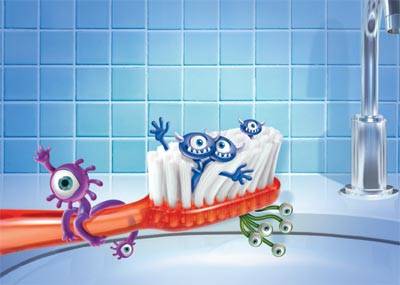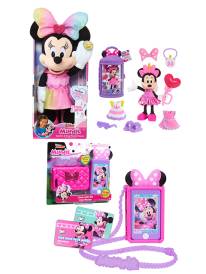Colgate Toothbrush

SO.... WHAT'S LURKING IN YOUR TOOTHBRUSH?!
As many people are already aware, the bathroom is riddled with germs (often even when it looks clean!), with your toothbrush in particular being a popular breeding ground for bacteria, fungus and germs - also known as 'invisible nasties.'
If you could actually see what was lurking beneath those toothbrush bristles, would you still put it in your mouth?
An unhealthy and germ-infested toothbrush may contribute to poor oral health, which is why it is important to not only take good care of your brush, but ensure you don't hang on to the same toothbrush for too long.
"Dentists recommend that people change their toothbrushes at least every three months, worn out toothbrushes are much less effective at removing plaque from teeth and may damage gums," says Barbara Shearer, Colgate's resident dentist and Scientific Affairs Manager.
"Not only do the bristles splay and lose their effectiveness in getting to all those tricky corners around your teeth, but bacteria, fungi and possibly viruses are able to multiply around the toothbrush bristles and potentially contribute to oral infections," she continues. "This problem is worse if the toothbrushes are stored with a cover and not allowed to dry, or are too close to the toilet area."
80 percent of oral bacteria are not actually on teeth, which is why other parts of your mouth should also not be overlooked. Brushes such as the Colgate 360 toothbrush however, help you to achieve a whole mouth clean by attending to not only teeth, but the gums, cheeks and tongue. Similar variants include the Colgate 360 MicroSonic battery powered toothbrush and Colgate 360 Sensitive toothbrush.
Colgate's tips for a healthy toothbrush (and healthy mouth):
Make sure you let your toothbrush dry between uses
After using your toothbrush, shake it vigorously under tap water and store in an upright position so it can air out
Keep your bathroom as clean and germ-free as possible, including closing the toilet lid when you flush
Try to keep your toothbrush from touching others when it is stored, to prevent cold and flu viruses from being passed between brushes
Remember to change your toothbrush every three months, and after you've had a cold, the flu, a mouth infection or a sore throat (to prevent re-infection)
Brush twice daily using a fluoride toothpaste and a toothbrush that cleans teeth, gums, cheeks and tongue
To find out more ways to keep toothbrush germs at bay, or to sign up for free quarterly reminder emails from Colgate about changing your toothbrush, head to www.betteroralhealth.com.au.
So what are you waiting for? Throw out that old, germ-ridden toothbrush (along with its invisible nasties!), and get started on improving your oral health today.
As many people are already aware, the bathroom is riddled with germs (often even when it looks clean!), with your toothbrush in particular being a popular breeding ground for bacteria, fungus and germs - also known as 'invisible nasties.'
If you could actually see what was lurking beneath those toothbrush bristles, would you still put it in your mouth?
An unhealthy and germ-infested toothbrush may contribute to poor oral health, which is why it is important to not only take good care of your brush, but ensure you don't hang on to the same toothbrush for too long.
"Dentists recommend that people change their toothbrushes at least every three months, worn out toothbrushes are much less effective at removing plaque from teeth and may damage gums," says Barbara Shearer, Colgate's resident dentist and Scientific Affairs Manager.
"Not only do the bristles splay and lose their effectiveness in getting to all those tricky corners around your teeth, but bacteria, fungi and possibly viruses are able to multiply around the toothbrush bristles and potentially contribute to oral infections," she continues. "This problem is worse if the toothbrushes are stored with a cover and not allowed to dry, or are too close to the toilet area."
80 percent of oral bacteria are not actually on teeth, which is why other parts of your mouth should also not be overlooked. Brushes such as the Colgate 360 toothbrush however, help you to achieve a whole mouth clean by attending to not only teeth, but the gums, cheeks and tongue. Similar variants include the Colgate 360 MicroSonic battery powered toothbrush and Colgate 360 Sensitive toothbrush.
Colgate's tips for a healthy toothbrush (and healthy mouth):
Make sure you let your toothbrush dry between uses
After using your toothbrush, shake it vigorously under tap water and store in an upright position so it can air out
Keep your bathroom as clean and germ-free as possible, including closing the toilet lid when you flush
Try to keep your toothbrush from touching others when it is stored, to prevent cold and flu viruses from being passed between brushes
Remember to change your toothbrush every three months, and after you've had a cold, the flu, a mouth infection or a sore throat (to prevent re-infection)
Brush twice daily using a fluoride toothpaste and a toothbrush that cleans teeth, gums, cheeks and tongue
To find out more ways to keep toothbrush germs at bay, or to sign up for free quarterly reminder emails from Colgate about changing your toothbrush, head to www.betteroralhealth.com.au.
So what are you waiting for? Throw out that old, germ-ridden toothbrush (along with its invisible nasties!), and get started on improving your oral health today.
MORE





